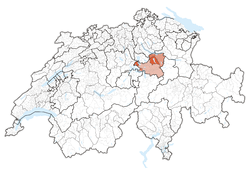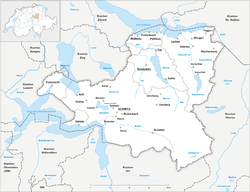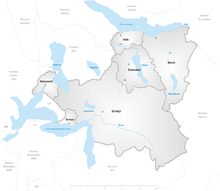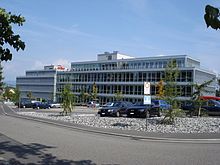- Canton of Schwyz
-
Kanton Schwyz — Canton of Switzerland — 
Coat of armsCoordinates: 47°4′N 8°45′E / 47.067°N 8.75°ECoordinates: 47°4′N 8°45′E / 47.067°N 8.75°E Capital Schwyz Largest City Freienbach Subdivisions 30 municipalities, 6 districts Government – Executive Regierungsrat (7) – Legislative Kantonsrat (100) Area[1] – Total 907.92 km2 (350.5 sq mi) Population (12/2009)[2] – Total 144,686 – Density 159.4/km2 (412.7/sq mi) Highest point 2,802 m (9,193 ft) - Bös Fulen Lowest point 406 m (1,332 ft) - Lake Zurich Joined 1291 Abbreviation SZ Languages German Website SZ.ch Schwyz (Standard German
 Schwyz (help·info)) is a canton in central Switzerland between the Alps in the south, Lake Lucerne in the east and Lake Zurich in the north, centered around and named after the town of Schwyz.
Schwyz (help·info)) is a canton in central Switzerland between the Alps in the south, Lake Lucerne in the east and Lake Zurich in the north, centered around and named after the town of Schwyz.It is one of the founding cantons of Switzerland; Switzerland's Standard German name, Schweiz, is derived from the name of the canton, and the flag of Switzerland from its coat of arms. For the history of the name, see Schwyz. The Swiss Federal Charter is on display in Schwyz. Northeast of the town of Schwyz is the Einsiedeln Abbey.
In June 2008, Schwyz was the only one of Switzerland's 26 cantons to vote in favor of a failed measure that would have subjected Swiss citizenship applications to a popular vote.
Contents
History
There are findings that show that people were living in the area of the canton of Schwyz thousands of years ago. Many of these findings are concentrated in the north of the canton, in the area of Hurden and Freienbach on Lake Zürich. Many of the findings date back 5000 years. Stone and bronze tools were recovered from these sites.
About 1400 years ago, the Allemanni settled in the area of the canton. This influenced agriculture and the way of living of the locals. Christianity only arrived in the area by the late 7th century. There are churches in Tuggen and Schwyz that date back to this time.
In the 10th century the abbey of Einsiedeln became more and more powerful. It soon controlled many of the surrounding lands, many of which are outside the area today covered by the canton of Schwyz. The economy benefited from the transit across the Gotthard, but these profits attracted other powers, such as the Habsburgs.
On 1 August 1291 the canton of Schwyz founded the Swiss Confederation together with Uri and Unterwalden (Rütlischwur, Pact of the Rütli). It is one of the Four Forest Cantons (Vier Waldstätten): Schwyz, and the cantons of Uri, Obwalden and Nidwalden — the latter two being traditional subdivisions of the canton of Unterwalden — all located on the shores of the Vierwaldstättersee (Lake Lucerne). The canton of Schwyz took the leadership in the confederation early on. As early as 1320 the name of the canton was applied to the whole of the confederation. It was only in 1803, howerver, that the name Schweiz as derived from the canton of Schwyz became the official name of Switzerland. The flag of Switzerland is derived from the banner of Schwyz.
The rulers of Schwyz, little by little, expanded their area of influence. This included a number of small battles, such as the Alt Zürcherkrieg. In 1386 the canton of Schwyz won the Battle of Sempach and, as a result, greatly expanded its area. The Protestant reformation was resisted in the canton. At the Battle of Kappel in 1531 troops of Schwyz beat those of the reformation leader Huldrych Zwingli. Zwingli himself was the most prominent to die at this battle which killed hundreds of soldiers.
Between 1798 and 1803 the canton of Schwyz was part of the Helvetic Republic. Joseph Thomas Fassbind compiled a history of the canton during this period, published in the 1830s. After 1803 Schwyz regained its independence and most of the changes introduced by Napoleon were reverted. This led to frictions within the canton, leading to the separation of part of the canton. A canton of Schwyz Outer Countries was created in 1830, only to be re-unified with the other half in 1833. In 1845 the canton joined the separatist Roman Catholic league (Sonderbund). The venture of this league failed and the canton re-joined the confederation as an ordinary member.
The constitution of 1848 ended the openair assemblies (Landsgemeinde). The constitution was revised in 1876 and 1898.
Geography
The canton of Schwyz is located in central Switzerland. The river Sihl and the smaller Muota traverse the canton. About three quarters of the total area is considered productive land. Most of the land is hilly rather than mountainous, making it suitable for agriculture. Of the productive land, about 240 km² are forests. Lakes take up 65 km². This area is made up of parts of Lake Zürich and Lake Lucerne. Only a small part of Lake Zug is within the canton of Schwyz. The smaller lakes Lauerz (Lauerzersee) and Sihl (Sihlsee), however, are completely within the canton of Schwyz.
The highest elevation is the Bös Fulen at 2,802 m. Although not as high, the summits of the Rigi massif (Kulm, 1,798 m, and Scheidegg, 1,665 m) are probably the most famous mountains within the borders of the canton. The area of the canton is 908 km².
Political subdivisions
The Canton is divided into six districts and 30 municipalities, although the Einsiedeln, Küssnacht and Gersau districts comprise the municipality of the same name. The largest towns are Küssnacht and Pfäffikon.
District Municipalities Schwyz District Schwyz, Arth, Ingenbohl, Muotathal, Steinen, Sattel, Rothenthurm, Oberiberg, Unteriberg, Lauerz, Steinerberg, Morschach, Alpthal, Illgau, Riemenstalden Einsiedeln District Einsiedeln Gersau District Gersau Höfe District Wollerau, Freienbach, Feusisberg Küssnacht District Küssnacht am Rigi March District Lachen, Altendorf, Galgenen, Vorderthal, Innerthal, Schübelbach, Tuggen, Wangen, Reichenburg Demographics
The population of the canton (as of 31 December 2009) is 144,686.[2] As of 2007[update], the population included 24,262 foreigners, or about 17.2% of the total population.[3] The official language is German, although the people speak the Swiss German dialect of central Switzerland. The majority of the population (as of 2000[update]) is Roman Catholic (72%) with a Protestant minority (13%).[4]
Economy
Most of the canton relies on agriculture. The local breed of brown cattle is renowned. The textile industry used to be of great importance in the canton but has now almost ceased to exist; remnants are concentrated around the capital Schwyz. Located in the same area are many producers of fine furniture. There are a few large hydroelectric power plants in the canton.
Tourism is of importance in a number of regions, most notably in the centre of pilgrimage Einsiedeln. Einsiedeln is also a centre of winter sports. The mountain railways on the Rigi are well known around the country. Freienbach, in the north of the canton, is known for the lowest taxes in Switzerland. This has attracted a number of the rich.
The best known, worldwide product of the canton is the Swiss Army Knife manufactured by Victorinox in Ibach just downhill from the main town of Schwyz.
See also
Theodor Ab Yberg, head of the canton 1846-1847
External links
- Official site (German)
 Media related to Canton of Schwyz at Wikimedia Commons
Media related to Canton of Schwyz at Wikimedia Commons
References
- ^ Arealstatistik Standard - Kantonsdaten nach 4 Hauptbereichen
- ^ a b Swiss Federal Statistical Office, MS Excel document – Bilanz der ständigen Wohnbevölkerung nach Kantonen, Bezirken und Gemeinden (German) accessed 25 August 2010
- ^ Bundesamt fur Statistik (Federal Department of Statistics) (2008). "Ständige Wohnbevölkerung nach Staatsangehörigkeit, Geschlecht und Kantonen" (Microsoft Excel). http://www.bfs.admin.ch/bfs/portal/de/index/themen/01/02/blank/key/raeumliche_verteilung/kantone__gemeinden.html. Retrieved November 5, 2008.
- ^ Bundesamt fur Statistik (Federal Department of Statistics) (2004). "Wohnbevölkerung nach Religion" (Interactive Map). http://www.bfs.admin.ch/bfs/portal/de/index/themen/01/05/blank/key/religionen.html. Retrieved 2009-01-15.
Lake Zurich (Zürichsee)
Switzerland Canton of Zurich (Horgen · Meilen · Zurich) · Canton of St. Gallen (See-Gaster) · Canton of Schwyz (Höfe · March)Settlements Altendorf · Au · Bäch · Bollingen · Erlenbach · Feldbach · Feldmeilen · Freienbach · Herrliberg · Horgen · Hurden · Jona · Kehlhof · Kempraten · Kilchberg · Küsnacht · Lachen · Männedorf · Meilen · Nuolen · Oberrieden · Pfäffikon · Rapperswil · Richterswil · Rüschlikon · Schmerikon · Stäfa · Thalwil · Uerikon · Uetikon am See · Wädenswil · Zollikon · Zurich
Islands Au peninsula · Lützelau · UfenauRivers Valleys Limmattal · SihltalMountains Landmarks Transportation Three Cantons · Eight Cantons · Thirteen Cantons · coats of arms historical cantons: Unterwalden ·
Unterwalden ·  Basel ·
Basel ·  Appenzell · Baden · Bellinzona · Fricktal · Léman · Linth · Lugano · Oberland · Raetia · Säntis · WaldstättenCategories:
Appenzell · Baden · Bellinzona · Fricktal · Léman · Linth · Lugano · Oberland · Raetia · Säntis · WaldstättenCategories:- 1315 disestablishments
- Canton of Schwyz
- Cantons of Switzerland
- Former countries in Europe
- Imperial valleys
- States of the Holy Roman Empire
- States and territories established in 972
- States and territories established in 1240
- States and territories established in 1315
- Official site (German)
Wikimedia Foundation. 2010.






